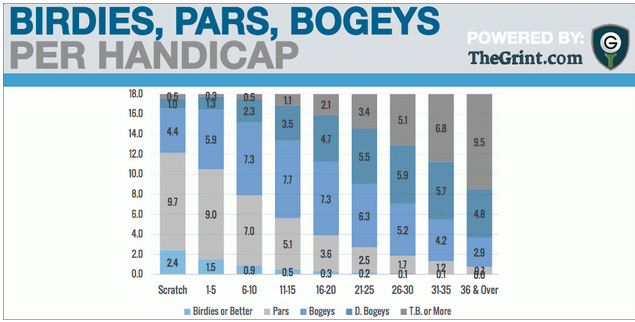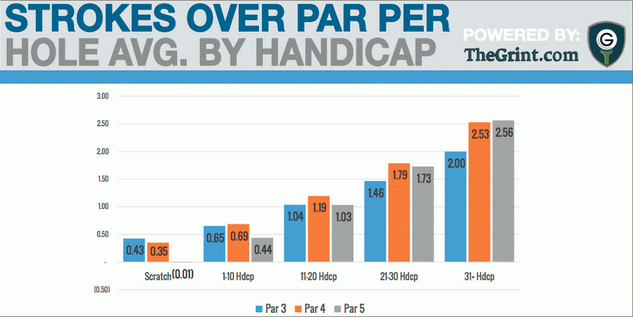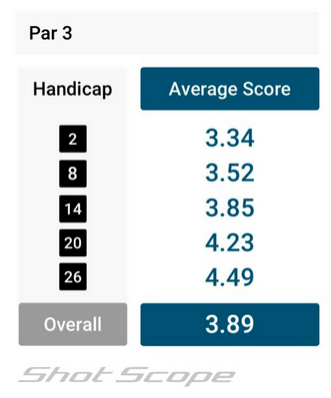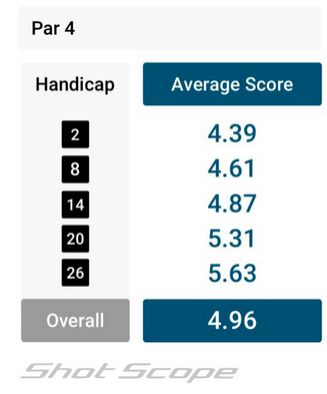As I mentioned in my last post, 2023 in Review – My Golf Goals and Results, I decided to do some research before setting my goals this year.
I googled “most important stats for golfers to improve their game.” All the articles I read said to lower a handicap golfers should not focus on birdies but focus on reducing bogeys, double bogeys or blowup holes. And golf stat experts said to focus on greens in regulation. And, of course, be a great putter. You may be thinking the same thing I did – nothing I didn’t already know and that doesn’t really help with my expectations or set goals. However, what was useful was finding the charts that show various key stats by handicap.
You will see Arccos data mentioned in each area because many articles use them as a data resource. Basically, Arccos is the pioneer of golf data tracking and analysis; per their website collecting over “600 million shots taken during 13 million rounds played by Arccos members in 162 countries” since it’s founding in 2012.
Greens In Regulation (GIR) Data
Lou Stagner, well known for his tweets on Arccos data really wants golfers to focus on “strokes gained” but for those that don’t want to get sensors for their clubs (or can’t afford them) he stated that GIR is the one traditional stat that is valuable because he said, “There is a very strong relationship between handicap and GIR%.” And Stagner has a great newsletter article with stats on different handicaps and GIR from various distances; and from the fairway versus rough. His charts have incredible detail and frankly more data than I need for my goals; also are too large to share in screenshots for this blog post.
A Golf Digest article dated 12/23/2023 has an interesting chart (see below) which also includes GIR Poximity. The screenshot below of Arccos data was in the article. I found another source “TheGrint” which is a social media and golf scoring app (second image) and the numbers are a bit different (they do not have as large a database as Arccos) but I thought it was good to see two sources.
This is the first time I found a chart that has GIR %, avg. # GIR per round, and GIR approach proximity all in one view. So for example, a 15 handicap when they get on the green in regulation they (on average) are 33 feet from the hole for their birdie putt.
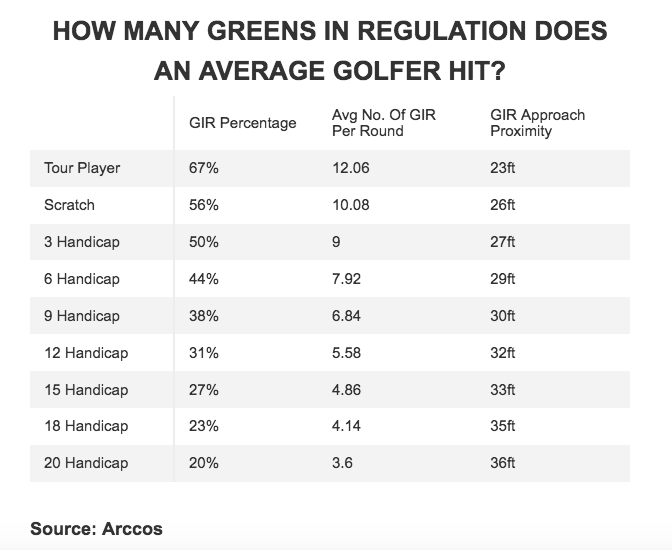
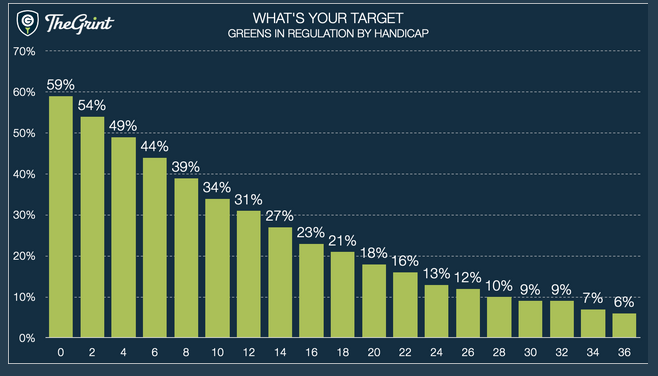
Putting and Three-Putt Avoidance
There’s no shortage of online content regarding putting. In 2021, Lou Stagner tweeted a 15 handicap will average 35 putts, (see below) which was a surprise to me because that was my 2023 average and I felt my putting really sucked.

Another data chart from The Grint shows 33 putts a round as the average for a 10 handicap.
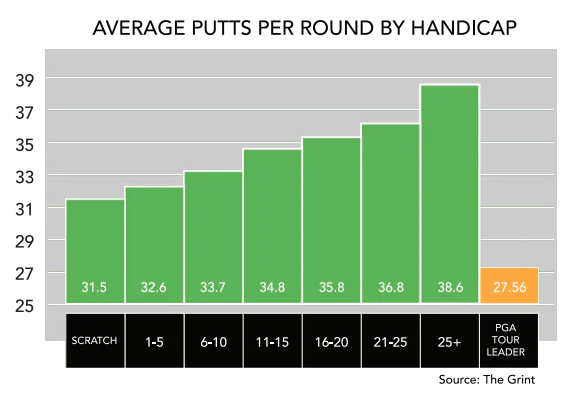
Another app for golfers that shares data is SwingU. They shared an interesting chart (below) in an October 2023 article, “Understanding Stats: Key Putting Stats by Handicap.”
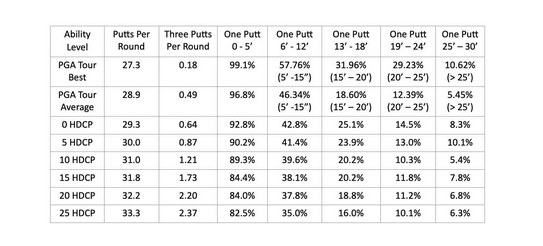
A new term I learned was “Three-Putt Avoidance” which is the PGA Tour putting statistic. It’s a percentage; so count the number of holes that you have played, work out the number of times you three-putted, and then determine the percentage. I found a 2017 My GolfSpy article with Arccos data for three-putt avoidance ( or percentage) percentages. Screenshot below:

Of course, you also need to consider distance from hole and common sense will tell us that the farther way the more likely a golfer will three-putt. I’m not sure three-putt avoidance is really how I want to track my putting but it was interesting.
Another diagram (below) from Golf.com article June 2023 shows 3-putts per round which to me is easier to translate to your game. I noticed that that Log Stagner’s tweet in 2021 had a 15 handicap at 2.5 three-putts per round vs 3.3 in the 2023 Arccos chart below. So I guess 15 handicaps using Arccos are either different golfers from 2021 data or perhaps the database in 2023 is so large that the data is actually more representative of the larger golf population.
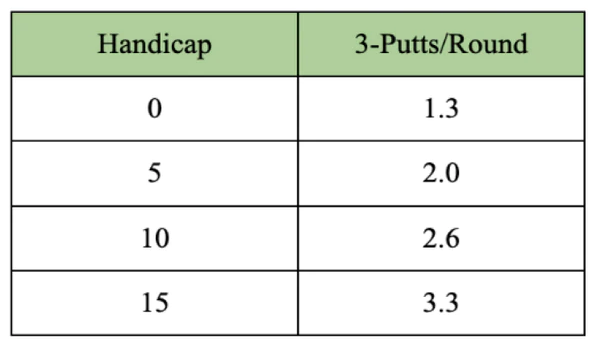
Scrambling (Up & Down)
I really could not find any useful data on scrambling. There was an article from SwingU with Up and Down data (from 50 yards) but my GHIN app doesn’t really get that specific. Here is the chart direct from the original 2018 data.
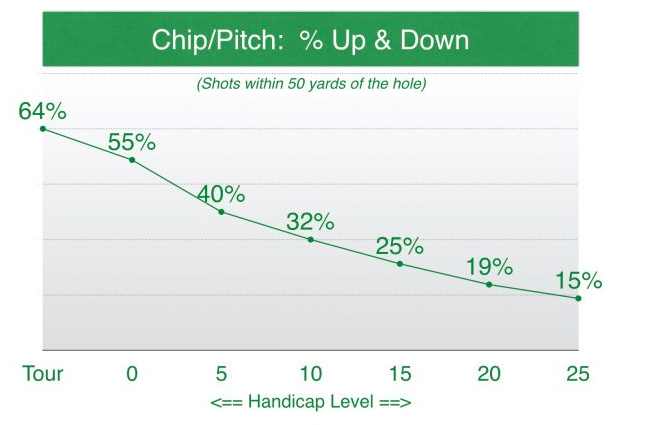
Score specific Data
I found articles that talked about the importance of reducing big numbers and strokes over par but I could not find 2023 data. I did find some interesting charts. The photo gallery below has data from two different MyGolfSpy Articles (one with TheGrint.com data from 2014 and one with ShotScope data from 2020 . I wanted to capture these charts (even thought they are a few years old) because the GHIN app captures birdies, pars, bogeys; and average score to par stat.
I also found another Arccos article from Oct 2023 titled, “Stats That Prove You’re Not That Bad At Golf” which compares a 5 Handicap to a 15 Handicap (chart below). The article also has an embedded Golf Monthly Youtube Video that is fun to watch. What surprised me is a 15 handicap only makes a birdie once every two rounds based on this data.
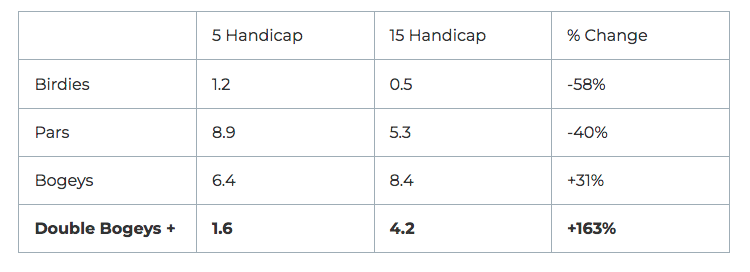
Again, Lou Stagner has a newsletter focused on “Performance by Hole Handicap” and for perspective he stated that “For scratch players, par 3s have a much higher scoring average (in relation to par) than par 5s….As handicap increases, this starts to shift, and eventually par 5s have a higher scoring average (in relation to par) than par 3s.”
My 2024 Goals
Overall Goal: I mentioned in my 2023 year-end review that my “big picture goal” for 2024 is to score more in the 80s (get myself off the 91 average score).
Goal #1 Greens In Regulation: Target average of 4.86 (15 Handicap stat) which is a good challenge given my 3.78 avg (21%) from last year. At a minimum I want to maintain my 2023 stat.
Goal #2 Putting: Targets are 33 putts or less per round and two or fewer three-putts per round. These were my targets last year. Based on the data above these are definitely stretch goals since these translate to a 10 handicap golfer. Always good to have “stretch goals.”
Goal #3 Scrambling: My “Up & Down” was 1.9 per round and as I mentioned about the data above is for 50 yards in and my stat from GHIN is not that specific. So if covert my 1.9 to a percentage (to relate to the chart above) then if I averaged four GIR in a round that would mean I would have 14 holes that provide an opportunity to up and down. So 1.9 of 14 is 13.57%.
I could use the chart above that shows a 15 handicap gets Up & Down from 50 yards 25% of the time. So again, if I only hit the green four times in a round, 25% of 14 greens missed would be 3.5 Up & Down goal for that round. As much as I want to improve my 2023 Up & Down stat I’m not sure is 25% is a the correct goal; but I’ll go with it. Of course, hopefully, I’ll hit more GIRs than four each round reducing the need to get up & down.
In some ways, I think I’m more interested in how close I get to the hole from a chip shot since proximity has a big impact on putting.
Goal #4 Fewer Blowup Holes: I was listening to a Mark Immelman podcast and he told a fascinating story about Jason Day. When Jason Day was the number one player in the world he “had a goal to average three on par 3s” and “for the season he averaged 3.01.” So a pro on tour had a goal to par all the par threes. I would have expected a very different goal. Fascinating!
I did see a nice reduction in double bogeys in 2023 (from 26% to 22%); and looking at the Arccos data feel pretty good about my number; but clearly I really want to continue reducing double bogeys or higher on the scorecard in a round. And of course, fewer blow up holes will hopefully lead to more pars!
Mental Game Goals
As I mentioned in my 2023 review there were a few months last year when I was definitely a head case chipping and putting. I worked on technique in September before my Pinehurst trip which helped give me a bit more confidence.
Last year I did listen to a golf podcast by Kathy Hart Wood, Above Par which was a big help in dealing with slow play or nerves in competition but since I love to learn, it’s time to see what other metal game process might be right for me. Of course, I will still listen to her podcast!
So my mental game goal is to find a “mental game process” (and there are plenty of books and videos on the mental game) and implement some of the tools suggested. Hopefully, I will find a process that also provides a way to track progress with the mental game. Of course, I’m sure I will blog about this once I decide on my plan.
I know one thing for sure, I’m not going to worry about goals when I play. These are strictly for after round evaluation so I can target my practice each week.

